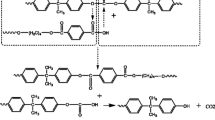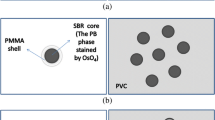Abstract
Methyl methacrylate-co-styrene-co-glycidyl methacrylate grafted polybutadiene (PB-g-MSG) and styrene-co-glycidyl methacrylate grafted polybutadiene (PB-g-SG) core-shell particles were prepared to toughen poly (butylene terephthalate) (PBT) and polycarbonate (PC) blends. The compatibilization reaction between the epoxy groups of glycidyl methacrylate and the carboxyl groups of PBT induced the PB-g-SG particles dispersed in the PBT phase. On the other hand, the good miscibility between PMMA (the shell phase of PB-g-MSG) and PC induced the PB-g-MSG particles dispersed in the PC phase. The different phase morphology led to different toughening behavior. The PBT/PC/PB-g-MSG blends with the PC encapsulated morphology showed much lower brittle-ductile transition core-shell particles content (10-15 wt% or 15-20 wt%) compared with the PBT/PC/PB-g-SG blends (20-25 wt%). The difference between the toughening efficiency of the core-shell particles was due to the change of deformation mechanisms. In PBT/PC/PB-g-MSG blends, the cavitation of PB rubber phase led to the occurrence of shear yielding of the matrix. While in the PBT/PC/PB-g-SG blends, the debonding between PBT and PC interface induced the shear yielding of the matrix. The variation of the core-shell particles dispersed phase morphology also affected the crystallization properties and DMA results of the PBT/PC blends. Modification of the phase morphology provided an useful strategy to prepare PBT/PC blends with higher toughening efficiency.








Similar content being viewed by others
References
He JX, Guo Y, Sun SL, Zhang HX (2015) J Polym Eng 3:247–256
Jose MRCAS, James T (2006) J Mater Chem 16:237–245
Kooshki RM, Ghasemi I, Karrabi M, Azizi H (2013) J Vinyl Addit Techn 19:203–212
Sonnier R, Viretto A, Taguet A, Lopez-Cuesta JM (2012) J Appl Polym Sci 125:3148–3158
Lei CH, Chen DH (2008) J Appl Polym Sci 109:1099–1104
DePolo WS, Baird DG (2009) Polym Compos 30:188–199
Kalkar AK, Siesler HW, Pfeifer F, Wadekar SA (2003) Polymer 44:7251–7264
Zaki MF, Elmaghraby EK, Elbasaty AB (2016) J Adhes Sci Technol 30:443–457
Bai HY, Zhang Y, Zhang YX, Zhang XF, Zhou W (2005) Polym Test 24:235–240
Bai HY, Zhang Y, Zhang YX, Zhang XF, Zhou W (2006) J Appl Polym Sci 101:54–62
Kalhoro MS, Gabrys BJ, Zajac W, King SM, Peiffer (2001) Polymer 42:1679–1690
Wen TT, Guo Y, Song SX, Sun SL, Zhang HX (2015) J Polym Res 22:222
Guo Y, He JX, Zhang XN, Sun SL, Zhang HX (2015) J Macromol Sci B 54:823835
Guo Y, Sun SL, Zhang HX (2014) RSC Adv 4:58880–58887
Lin GP, Lin L, Wang XL, Chen L, Wang YZ (2015) Ind Eng Chem Res 54:1282–1291
Sun SL, Zhang FF, Fu Y, Zhou C, Zhang HX (2013) J Macromol Sci B 52:861–872
Kuram E, Ozcelik B, Yilmaz F, Timur G, Sahin ZM (2014) Polym Compos 35:2074–2084
Kuram E, Timur G, Ozcelik B, Yilmaz F (2014) Mater Manuf Process 29:1260–1268
Zhang FF, Sun SL, Liu XY, Zhang LX, Zhang HX (2009) E-polymers 77:1–11
Wu JS, Wang K, Yu DM (2003) J Mater Sci 38:183–191
Wu JS, Mai YW, Yee AF (2000) J Mater Sci 35:307–315
Tseng WTW, Lee JS (2000) J Appl Polym Sci 76:1280–1284
Brady AJ, Keskkula H, Paul DR (1994) Polymer 35:3665–3672
Okamoto M, Shinoda Y, Kojima T, Inoue T (1994) Polymer 35:4868–4873
Memon AN (1994) J Appl Polym Sci 54:1059–1072
Hale W, Keskkula H, Paul DR (1999) Polymer 40:365–377
Oyamaa HT, Kitagawab T, Ougizawab T, Inouec T, Weberd M (2004) Polymer 45:10331043
Acknowledgments
This work was financially supported by the National Natural Science Foundation of China (51273025, 51272026, and 50803007) and Jilin Provincial Science & Technology Department (20140101104JC).
Author information
Authors and Affiliations
Corresponding author
Rights and permissions
About this article
Cite this article
Deng, B., Guo, Y., Song, S. et al. Effect of core-shell particles dispersed morphology on the toughening behavior of PBT/PC blends. J Polym Res 23, 210 (2016). https://doi.org/10.1007/s10965-016-1106-2
Received:
Accepted:
Published:
DOI: https://doi.org/10.1007/s10965-016-1106-2




